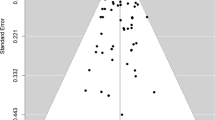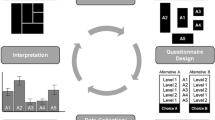Abstract
There are very few studies that quantify the interactions and tradeoffs between statistical and cognitive efficiency in designing stated-choice studies. While a conceptual framework for evaluating cognitive strategies would be desirable, Hensher adopts a strictly empirical approach in this experiment. The success of the study must be evaluated in light of his aggregating attributes rather than controlling the number of attributes, asymmetry in the narrow-range and wide-range attributes, and lack of orthogonality between the number of attributes and number of alternatives. Nevertheless, Hensher challenges uncritical acceptance of any given set of design features and correctly insists that we confirm our experience with rigorous, quantitative experiments.
Similar content being viewed by others
References
T. Arentze A. Borgers R. DelMistro H. Timmermans (2003) ArticleTitle‘Transport Stated Choice Responses: Effects of Task Complexity, Presentation Format and Literacy’ Transport Research E 39 229–244 Occurrence Handle10.1016/S1366-5545(02)00047-9
M. Ben-Akiva T. Morikawa F. Shiroishi (1992) ArticleTitle‘Analysis of the Reliability of Preference Ranking Data’ Journal of Business Research 24 149–164 Occurrence Handle10.1016/0148-2963(92)90058-J
R. Blamey J. Bennett J. Louviere M. Morrison J. Rolfe (2000) ArticleTitle‘A Test of Policy Labels in Environmental Choice Modeling Studies’ Ecological Economics 32 269–286 Occurrence Handle10.1016/S0921-8009(99)00101-9
K. J. Boyle T. P. Holmes M. F. Teisl B. Roe (2001) ArticleTitle‘Comparison of Conjoint Analysis Response Formats’ American Journal of Agricultural Economics 83 IssueID2 441–454 Occurrence Handle10.1111/0002-9092.00168
S. Bryan L. Gold R. Sheldon M. Buxton (2000) ArticleTitle‘Preference Measurement Using Conjoint Methods: An Empirical Investigation of Reliability’ Health Economics 9 385–395 Occurrence Handle10.1002/1099-1050(200007)9:5<385::AID-HEC533>3.0.CO;2-W
R. Y. Darmon D. Rouziès (1991) ArticleTitle‘Internal Validity Assessment of Conjoint Estimated Attribute Importance Weights’ Journal of The Academy of Marketing Science 19 315–322
W. Kuhfeld (2004) Marketing Research Methods in SAS, TS-694 SAS Institute Carey, North Carolina
J. J. Louviere (2001) ArticleTitle‘What If Consumer Experiments Impact Variances as Well as Means: Response Variability as a Behavioral Phenomenon’ Journal of Consumer Research 28 506–511 Occurrence Handle10.1086/323739
J. J. Louviere D. J. Street L. Burgess (2003) A 20+ Years Retrospective on Choice Experiments Wind Yoram E. Green Paul (Eds) Marketing Research and Modeling: Progress and Prospects Kluwer Academic Publishers New York
J. Louviere D. Street R. Carson A. Ainslie J. DeShazo T. Cameron D. Hensher R. Kohn T. Marley (2002) ArticleTitle‘Dissecting the Random Component of Utility’ Marketing Letters 13 177–193 Occurrence Handle10.1023/A:1020258402210
J. Louviere D. Hensher J. Swait (2002) Stated Choice Methods: Analysis and Application Cambridge University Press Cambridge, UK
T. Maddala K. A. Phillips F. R. Johnson (2003) ArticleTitle‘An Experiment on Simplifying Conjoint Analysis Exercises for Measuring HIV Testing Preferences’ Health Economics 12 IssueID12 1035–1047 Occurrence Handle10.1002/hec.798
I. Simonson A. Tversky (1992) ArticleTitle‘Choice in Context: Tradeoff Contrast and Extremeness Aversion’ Journal of Marketing Research 29 IssueID4 281–296 Occurrence Handle10.2307/3172740
P. Slovic (1995) ArticleTitle‘The Construction of Preference’ American Psychologist 50 364–371 Occurrence Handle10.1037/0003-066X.50.5.364
J. -B. E. M. Steenkamp D. R. Wittink (1994) ArticleTitle‘The Metric Quality of Full-Profile Judgments and the Number-of-Attribute-Levels Effect in Conjoint Analysis’ International Journal of Research in Marketing 11 275–286 Occurrence Handle10.1016/0167-8116(94)90006-X
Train, K. and G. Sonnier (2004), ‘Mixed Logit with Bounded Distributions of Partworths, Forthcoming’, in A. Alberini and R. Scarpa eds., Applications of Simulation Methods in Environmental and Resource Economics. Kluwer Academic Publisher
D. Wand L. Jiuqun H. Timmermans (2001) ArticleTitle‘Reducing Respondent Burden, Information Processing Effort, and Incomprehensibility in Stated Preference Surveys: Principles and Properties of Paired Conjoint Analysis’ Transportation Research Record 1768 71–78
White, P. J., R. D. Johnson and J. J. Louviere (1998), The Effect of Attribute Range and Variance on Weighted Estimates. Department of Marketing, The University of Sydney (unpublished paper)
Author information
Authors and Affiliations
Corresponding author
Rights and permissions
About this article
Cite this article
Johnson, F.R. Comment on “Revealing Differences in Willingness to Pay Due to the Dimensionality of Stated Choice Designs: An Initial Assessment”. Environ Resource Econ 34, 45–50 (2006). https://doi.org/10.1007/s10640-005-3783-x
Accepted:
Issue Date:
DOI: https://doi.org/10.1007/s10640-005-3783-x




